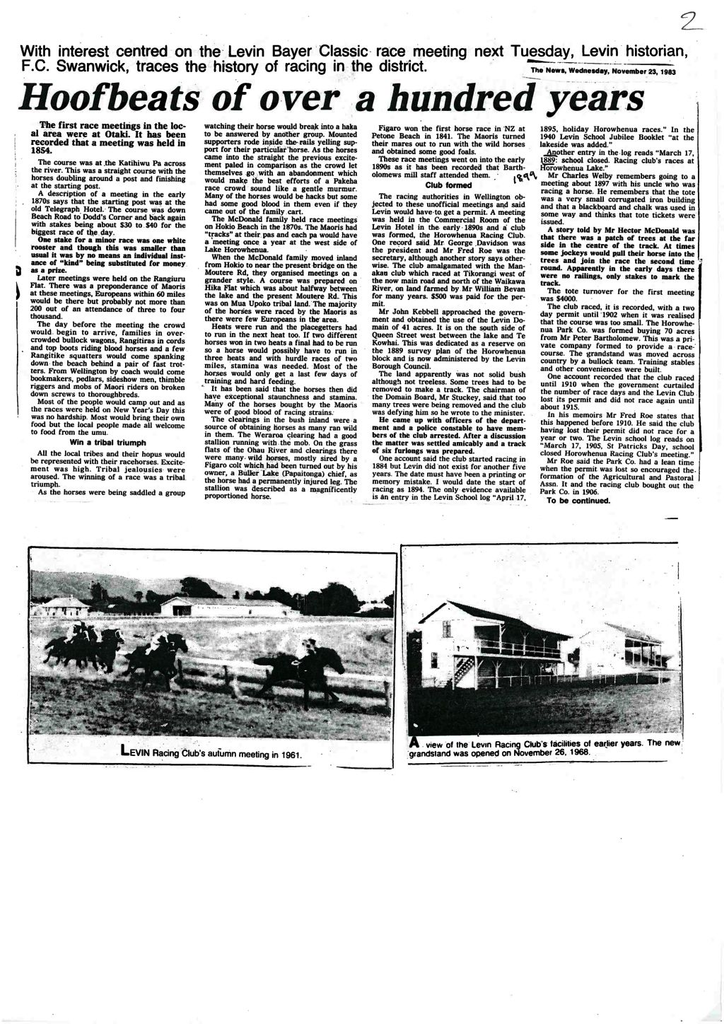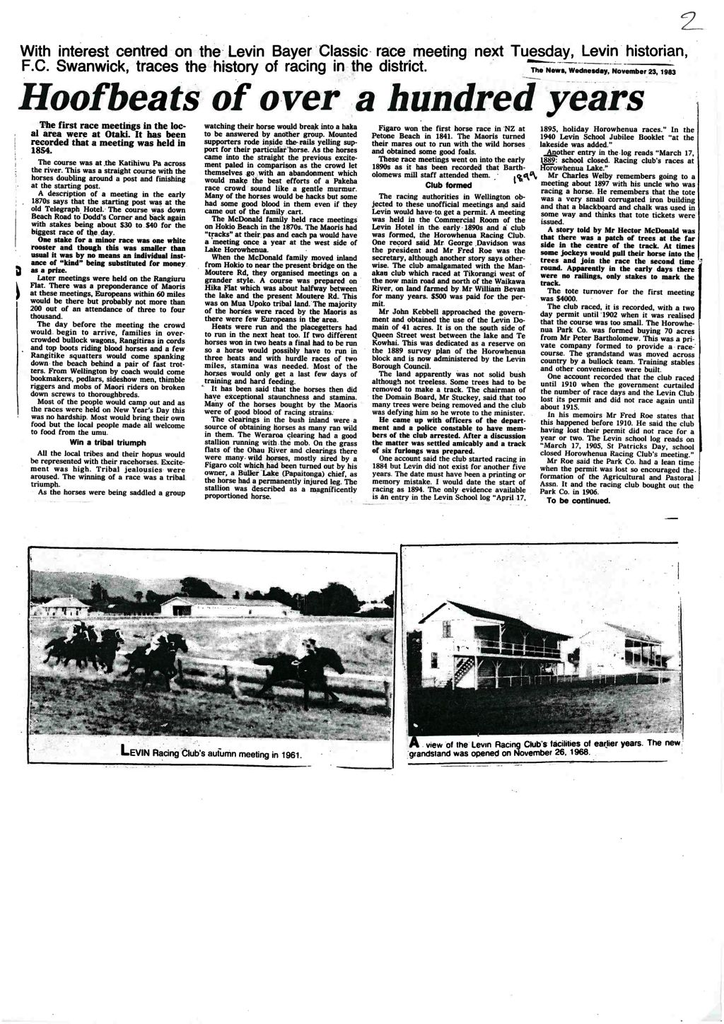Hoofbeats over 100 years - Part 1
- Description
This text that follows is the content of the attached PDF.
The course was at the Katihiwu Pa across the river. This was a straight course with the horses doubling around a post and finishing at the starting post.
A description of a meeting in the early 1870s says that the starting post was at the old Telegraph Hotel. The course was down Beach Road to Dodd's Corner and back again with stakes being about $30 to $40 for the biggest race of the day.
One stake for a minor race was one white rooster and though this was smaller than usual it was by no means an individual instance of "kind" being substituted for money as a prize.
Later meetings were held on the Rangiuru Flat. There was a preponderance of Maoris at these meetings, Europeans within 60 miles would be there, but probably not more than 200 out of an attendance of three to four thousand.
The day before the meeting the crowd would begin to arrive, families in over-crowded bullock wagons, Rangitiras in cords and top boots riding blood horses and a few Rangitikei squatters would come spanking down the beach behind a pair of fast trotters. From Wellington by coach would come bookmakers, pedlars, sideshow men, thimble riggers and mobs of Maori riders on broken down screws to thoroughbreds.
Most of the people would camp out and as the races were held on New Year's Day this was no hardship. Most would bring their own food but the local people made all welcome to food from the umu.
Win a tribal triumph
All the local tribes and their hapus would be represented with their racehorses. Excitement was high. Tribal jealousies were aroused. The winning of a race was a tribal triumph.
As the horses were being saddled a group watching their horse would break into a haka to be answered by another group. Mounted supporters rode inside the rails yelling support for their particular horse. As the horses came into the straight the previous excitement paled in comparison, as the crowd let themselves go with an abandonment which would make the best efforts of a Pakeha race crowd sound like a gentle murmur. Many of the horses would be hacks but some had some good blood in them, even if they came out of the family cart.
The McDonald family held race meetings on Hokio Beach in the 1870s. The Maoris had "tracks" at their pas and each pa would have a meeting once a year at the west side of Lake Horowhenua.
When the McDonald family moved inland from Hokio to near the present bridge on the Moutere Rd, they organised meetings on a grander style. A course was prepared on a grander style. A course was prepared on Hika Flat which was about halfway between the lake and the present Moutere Rd. This was on Mua Upoko tribal land. The majority of the horses were raced by the Maoris as there were few Europeans in the area.
Heats were run and the placegetters had to run in the next heat too. If two different horses won in two heats a final had to be run, so a horse would possibly have to run in three heats and with hurdle races of two miles, stamina was needed. Most of the horses would only get a last few days of training and hard feeding.
It has been said that the horses then did have exceptional staunchness and stamina. Many of the horses bought by the Maoris were of good blood of racing strains.
The clearings in the bush inland were a source of obtaining horses as many ran wild in them. The Weraroa clearing had a good stallion running with the mob. On the grass flats of the Ohau River and clearings there were many wild horses, mostly sired by a Figaro colt which had been turned out by his owner, a Buller Lake (Papaitonga) chief, as the horse had a permanently injured leg. The stallion was described as a magnificently proportioned horse.
Figaro won the first horse race in NZ at Petone Beach in 1841. The Maoris turned their mares out to run with the wild horses and obtained some good foals.
These race meetings went on into the early 1890s as it has been recorded that Bartholomew’s mill staff attended them.
Club formed
 The racing authorities in Wellington objected to these unofficial meetings and said Levin would have to get a permit. A meeting was held in the Commercial Room of the Levin Hotel in the early 1890s and a club was formed, the Horowhenua Racing Club. One record said Mr George Davidson was the president and Mr Fred Roe was the secretary, although another story says otherwise. The club amalgamated with the Manakau club which raced at Tikorangi west of the now main road and north of the Waikawa River, on land farmed by Mr William Bevan for many years. $500 was paid for the permit.
The racing authorities in Wellington objected to these unofficial meetings and said Levin would have to get a permit. A meeting was held in the Commercial Room of the Levin Hotel in the early 1890s and a club was formed, the Horowhenua Racing Club. One record said Mr George Davidson was the president and Mr Fred Roe was the secretary, although another story says otherwise. The club amalgamated with the Manakau club which raced at Tikorangi west of the now main road and north of the Waikawa River, on land farmed by Mr William Bevan for many years. $500 was paid for the permit.Mr John Kebbell approached the government and obtained the use of the Levin Domain of 41 acres. It is on the south side of Queen Street west between the Lake and Te Kowhai. This was dedicated as a reserve on the 1889 survey plan of the Horowhenua block and is now administered by the Levin Borough Council.
The land apparently was not solid bush although not treeless. Some trees had to be removed to make a track. The chairman of the Domain Board, Mr Stuckey, said that too many trees were being removed and the club was defying him, so he wrote to the minister.
He came up with officers of the department and a police constable to have members of the club arrested. After a discussion the matter was settled amicably and a track of six furlongs was prepared.
One account said the club started racing in 1884 but Levin did not exist for another five years. The date must have been a printing or memory mistake. I would date the start of racing as 1894. The only evidence available is an entry in the Levin School log "April 17, 1895, holiday Horowhenua races." In the 1940 Levin School Jubilee Booklet "at the lakeside was added."
Another entry in the log reads "March 17, 1889: school closed. Racing club's races at Horowhenua Lake."
Mr Charles Welby remembers going to a meeting about 1897 with his uncle who was racing a horse. He remembers that the tote was a very small corrugated iron building and that a blackboard and chalk was used in some way and thinks that tote tickets were issued.
A story told by Mr Hector McDonald was that there was a patch of trees at the far side in the centre of the track. At times some jockeys would pull their horse into the trees and join the race the second time round. Apparently in the early days there were no railings, only stakes to mark the track.
The tote turnover for the first meeting was $4000.
The club raced, it is recorded, with a two day permit until 1902 when it was realised that the course was too small. The Horowhenua Park Co. was formed buying 70 acres from Mr Peter Bartholomew. This was a private company formed to provide a race-course. The grandstand was moved across country by a bullock team. Training stables and other conveniences were built.
One account recorded that the club raced until 1910 when the government curtailed the number of race days and the Levin Club lost its permit and did not race again until about 1915.
 In his memoirs Mr Fred Roe states that this happened before 1910. He said the club having lost their permit did not race for a year or two. The Levin school log reads on "March 17, 1905, St Patrick’s Day, school closed Horowhenua Racing Club's meeting."
In his memoirs Mr Fred Roe states that this happened before 1910. He said the club having lost their permit did not race for a year or two. The Levin school log reads on "March 17, 1905, St Patrick’s Day, school closed Horowhenua Racing Club's meeting."Mr Roe said the Park Co. had a lean time when the permit was lost, so encouraged the formation of the Agricultural and Pastoral Assn. It and the racing club bought out the Park Co. in 1906.
To be continued …
Identification
- Date
- November 23, 1983
Taxonomy
- Community Tags


